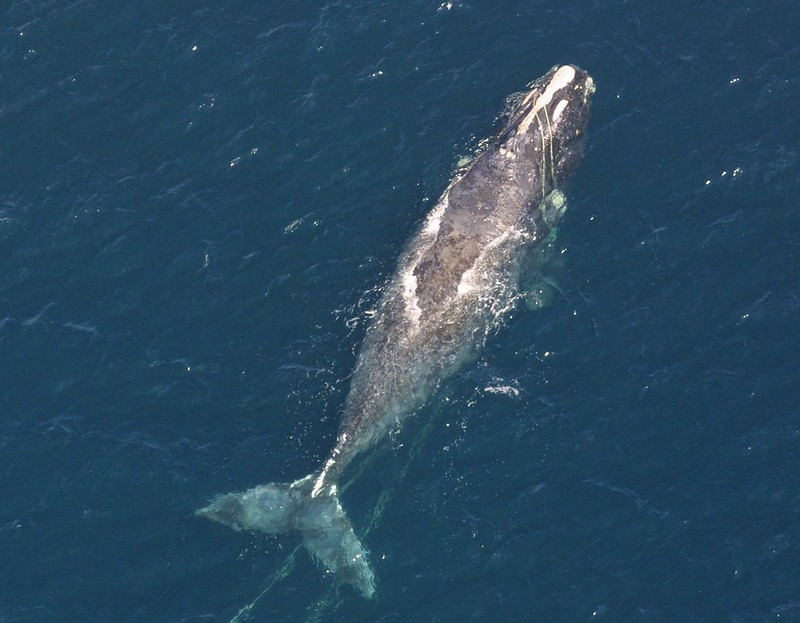
North Atlantic Right Whale Facts
- This majestic marine mammal is most typically referred to by the informative common name of the North Atlantic Right Whale. Yet, this majestic beauty does have other general titles. These include such terms as black right whale, bone whale, and Biscay whale, among others.
- Scientific professionals, however, perhaps know it better by its purely technical designation. Unfortunately, though, as often occurs, that’s a somewhat difficult tag for the layperson to pronounce. That’s because it holds the complex formal epithet of Eubalaena glacialis.
- The magnificent creature received that appellation due to the efforts of Otto Friedrich Müller. That highly respected Danish naturalist accomplished the first recognition of it as a separate and distinct species. He managed that scientifically noteoworthy deed in the year 1776.
- The massive animal currently represents one of only three recognized species placed within its entire genus. Previously, however, scientists classified all three of these as a single species. This marvel of Nature is now a protected species across much of their native habitat range.
- Sadly, though, the amazing North Atlantic Right Whale currently finds itself in a most precarious position. Though it’s now protected by legal decrees, humans once hunted it nearly to the point of extinction. It still has a very small population, and recovery proceeds slowly.
- Due to these severe factors, the IUCN currently lists the creature as Critically Endangered. The whale faces multiple threats to its continued existence as a species. Most of these perils stem from the actions of mankind. They include the dangers of habitat loss and climate change.
Related Articles
North Atlantic Right Whale Physical Description
The beautiful North Atlantic Right Whale certainly captures the attention of those individuals fortunate enough to encounter it. Like its cousins, it also does so for a variety of reasons. That’s due to the fact that, as with many cetaceans, it possess both great beauty and impressive dimensions.
It also follows another evolutionary pattern typical to its many relatives around the world. That’s the fact that it displays a certain amount of the physiological characteristic of sexual dimorphism. In this species, that trait manifests itself purely in terms of size. Females are slightly larger than males.
The gender-based difference remains comparatively minor, though. Overall, mature individuals reach an average length measuring approximately 43 – 52 ft (13 – 16 m). Weights among examples frequently vary significantly, however, usually ranging from 88,185 – 154,324 lb (40,000 – 70,000 kg).
Exceptional specimens nevertheless do sometimes occur, wholly regardless of their gender. The most physically impressive examples ever reliably confirmed attained lengths equaling 61 ft (18.6 m), and amazingly weighed roughly 234,000 lb (106,000 kg). Such examples remain rare, though.
Other than size, both sexes of the North Atlantic Right Whale present the same general outward appearance. Its most distinguishing attribute, setting it apart from other cetaceans, is its lack of a dorsal fin on its back. It also has a large head that accounts for a large part of its total length.
Exact patterns of coloring additionally vary markedly between individuals, though nonetheless within certain ranges. These primarily consist of various shades or black or gray. A few individuals, however, also display random patches of an off-white, usually on their throats and stomachs.
- Kingdom: Animalia
- Phylum: Chordata
- Class: Mammalia
- Order: Artiodactyla
- Family: Balaenidae
- Genus: Eubalaena
- Species: E. glacialis
North Atlantic Right Whale Distribution, Habitat, and Ecology
The gorgeous North Atlantic Right Whale evolved as native to only a moderate expanse of the marine regions of the surface of the earth. Its very name provides the location of that zone of habitation. It developed as endemic to the most northern areas of the Atlantic Ocean.
To the north, that territory extends as far as the Labrador Sea, located near Greenland, as well as other regions at the same longitude. To the south that only reaches to Florida, in the United States, in the southeast. That range also extends to around the northwest coast of South America.
The remarkable cetacean also evolved decidedly clear preferences regarding its choice of habitat. Yet, the nature of this favoritism serves to drastically limits its available range. This marvel of evolution primarily, but not solely, chooses to reside in waters along the continental shelf.
Individuals and groups nevertheless do occasionally venture much farther out to sea, roaming into areas of very deep water. The species also migrates seasonally within this greater territory, generally between feeding grounds. This migratory action occurs both as individuals and in groups.
The amazing North Atlantic Right Whale, just like its many kindred located around the world, evolved as fully carnivorous in nature. Its diet consists primarily of copious quantities of relatively small crustaceans and other invertebrates. These include pteropods, krill, and similar creatures.
Following mating activities, females carry the young for about 1 year. The mother typically nurses the offspring for 1 – 2 years. Even after that, though, calves often stay with or near the mother until around the age of 10. Minus human interaction, an averae lifespan equals about 100 years.
Species Sharing Its Range
Check out out other articles on 3 Surprising South American Moths, Executioner Wasp, European Honey Buzzard, Deception Island, East African Lowland Honey Bee, Jelly Ear, Mangrove Monitor
